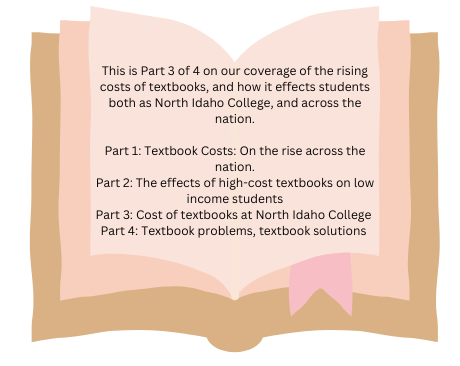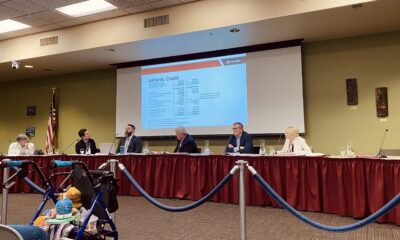Community
Cost of textbooks at North Idaho College
It is no surprise that the cost of textbooks is a burden on many students. Sadly, many of those same students choose to go without those textbooks, due to the knowledge many of those students have regarding the financial repercussions of buying or even renting those textbooks (be they physical or digital). The cost of a textbook can mean not eating for a week, which takes a massive health toll on the individual, or even have them replace healthy and organic options with unhealthy options, and fall victim to the stereotype of only being able to afford ramen and other foods which are unhealthy and cause health issues.
Students are busy. Busy with school, busy with work, busy with their personal lives and their relationships. One of the last things a student wishes to focus on is whether or not they are able to afford a textbook that is required by their professor/s. Those students receiving a Pell grant, scholarship, or gifted tuition get what essentially amounts to a free ride to college (assuming this covers their whole tuition and associated costs). There are, however, plenty of students who do not fall into this category for whatever reason. These students might receive some level or another of assistance, but the cost of attendance extracts a heavy toll on their financial decision making abilities, as they feel as though the only option they have for attending higher education is to take out student loans with predatory behavior. Even racking up federal student loans (both subsidized and unsubsidized) causes an economic burden on the individual which will affect them later in life when the time comes to pay back that borrowed money.
North Idaho College appears to lie somewhere in the middle. NIC offers students flexibility with their courseload. Many professors at NIC also give students the ability to pick whether or not they use the textbook/s requested. This certainly helps students, as many of those textbooks tend to not be used to the degree that might instill fear into students who would otherwise believe them to be the end all be all within the context of the coursework. Even better, many NIC professors give students digital copies of the texts that will be used in their assignments for free at either the start of the semester, or as the work is assigned. Even for those that do not do this, and also require the actual textbook to pass the class, many tech-savvy students are able to find LIBerty in the GENeralized areas you can find these works for free.
Those unable to take the hint, or unable to find the version they need of their textbooks, are oftentimes left with the only option of purchasing their textbooks from either an online source, or in the campus bookstore. The prices at the bookstore range from beyond reasonable to beyond ridiculous. Many of the core textbooks cost upwards of $380, with these core textbooks categories ranging from math, to science, to digital communications and forensics. The more reasonable costs are between $1.45 (for a roughly 100 sheet printout of a required biology book) to $30 (“Forest Dreams, Forest Nightmares”).
Many students, however, are not quite satisfied. While they recognize the reasoning behind some of the books being priced as they are, many are left flabbergasted at the more ludicrous examples. “Some of them can be a little overpriced, especially since we’re already paying for it with tuition. It starts to add ip when you need to buy four to five books per semester. It’s one of my least favorite things to do at the start of each semester,” said Garry Winthorpe, a student at NIC.
It’s not just regular students at NIC who are feeling the financial punch to their wallets. Bryce Lindsey is a dual credit student who loves math. While speaking to him on the price of textbooks, he adds, “I’m a dual credit student, but they are super expensive. For example, my Calculus textbook costs $300. Why is that? This affects my grades as I now have to find additional work to help try and cover the cost of the required textbooks,” he said.
When attempting to reach out to the bookstore, we had heard initial interest to speak to us on their prices, yet have yet to hear back from them. We chalk this up to them being busy. However, the group that runs the (at least online portion of) bookstore – eFollet states that “Campus stores buy books directly from the publisher or from a wholesaler. Then the campus store increases the selling price usually between 25 and 28 percent. For every dollar spent on a textbook, the campus store gets 22 cents.4 Of the 22 cents, 18 cents goes to operating the store, which includes paying utilities and taxes. That 18 cents also needs to cover the payroll for the employees who help students find what they need and explain their course material program options. The remaining money — about four- and-a-half cents of every dollar spent on a textbook — is the campus store’s profit.” This might explain some of the cost, yet those figures do not quite seem to add up. Payroll and initial cost is one thing, yet the claim at the pre-bookstore purchase level appears to be off. Even if these numbers are in fact accurate, the fact that digital textbooks oftentimes go for near or the same price as the printed work completely throws the “overhead” argument out the window. When you are hosting a file on your site for relatively little, even if you experience a good deal of traffic, far more goes towards your profit margin, as compared to the physical book and materials needed to create, print, and distribute the text.
In part 4, we will look at what North Idaho College is doing to combat the issue of rising costs (though some of this was covered in this article) of their textbook offerings, as well as steps that can be taken at a national level and by the publishers themselves.














